![]() The Pacific War Online Encyclopedia
The Pacific War Online Encyclopedia
|
| Previous: SM1 Fighter Direction Radar | Table of Contents | Next: Small Seaplane Tenders (AVP) |
At the very tip of the divisional wedge was the infantry platoon and its small arms: pistols, rifles, antitank rifles, submachine guns, and machine guns.
All small arms of the 20th Century fired ammunition
consisting of a solid bullet crimped into the front of a
thin-walled brass or steel cartridge. The cartridge also contained
gunpowder and a
primer containing a tiny charge of a highly sensitive explosive, such as lead styphnate or a mixture of
potassium perchlorate and powdered aluminum. The bullet itself
was usually made of lead, often with a copper or steel jacket.
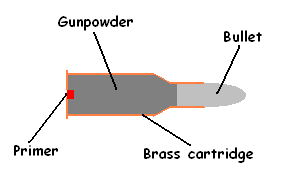 |
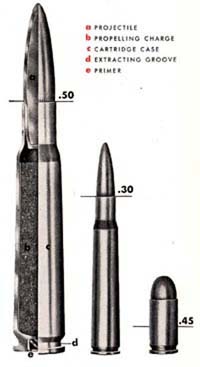 |
There was considerable variation in small arms ammunition, but the diagram above left shows a representative high power military round. Although other arrangements were possible, almost all military rounds placed the primer at the center of the rear of the cartridge, as shown. The use of a cartridge with a larger diameter than the bullet, except where it necked down to hold the bullet, is characteristic of high power rounds, while low power rounds (such as pistol or submachine gun rounds) often used a cartridge only slightly greater in diameter than the bullet. The rim at the base of the cartridge provided something for the extraction mechanism to latch onto to pull the spent cartridge out of the chamber after the round was fired. Many cartridges using a recessed extracting groove in place of a rim. The photograph above right shows a selection of ammunition rounds of various types.
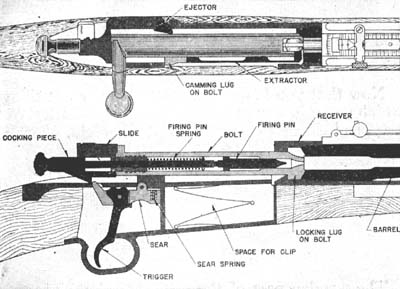 |
|
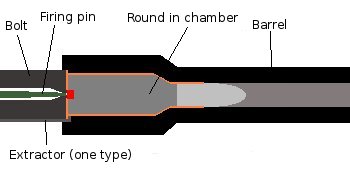 |
The diagram above left shows the detailed mechanism of the Springfield rifle, which was a typical bolt-action rifle used by American forces early in the war. The diagram to the right is a simplified diagram showing the basic elements of a firearm. When the weapon was loaded, a round of ammunition was locked into a chamber at the rear of a hollow metal tube, or barrel, by a metal bolt. Except in certain automatic weapons, the bolt itself was locked to the rear of the barrel to ensure a tight seal. When the weapon's trigger was pulled, a firing pin struck the primer, crushing it. This detonated the sensitive primer charge, which in turn ignited the gunpowder inside the cartridge. In this confined space, the gunpowder burned extremely rapidly, generating hot gas at very high pressure (as much as 50,000 ppsi or 340 MPa for a 0.50 machine gun round). The pressure of the gas pushed the bullet forward and out of the barrel at a velocity of a few hundred to a few thousand feet per second (a hundred to a thousand meters per second), depending on the size of the propellant charge, the length of the barrel, and the weight of the bullet. All other things being equal, the muzzle velocity was greater for a lighter bullet, a longer barrel, or a larger propellant charge. However, lighter bullets tended to slow down more quickly after leaving the barrel due to air resistance.
The brass cartridge was pressed tightly against the bolt and the walls of the chamber by the propellant gas, forming a gas-tight seal and ensuring that the hot propellant gas had nowhere to go but out the barrel behind the bullet. The bullet was also designed to form a gas-tight seal with the walls of the barrel. The interior of the barrel was rifled; that is, it had shallow spiral grooves cut into it. The rifling in the barrel imparted a spin to the bullet, which greatly increased its accuracy. Once the bullet was fired, the empty cartridge was extracted from the chamber by an extractor that hooked onto the rim or extracting groove at the rear of the cartridge. A new round could now be loaded.
All small arms were subject to fouling by a combination
of gunpowder residues and lead from the bullets. Fouling could be
minimized by firing at a lower muzzle velocity, by firing bullets
with copper or steel jackets, or by plating the inside of the
barrel with chromium (an
expensive process reserved for the most sophisticated small arms.)
Nevertheless, all small arms required periodic cleaning to remove
fouling and other grime, and the skill of rapidly breaking down
and reassembling their small arms was part of the basic training of new recruits.
International law prohibited the use of bullets designed to expand or explode on impact with a human target. (This restriction did not apply to antiaircraft or antitank ammunition.) The prohibition of expanding or exploding bullets reflected the belief that seeking to kill rather than merely disable the enemy was cruelty beyond the necessity of war. In practical terms, while a wounded soldier might live to fight another day, he also required the assistance of his comrades, so a wounded soldier reduced the manpower immediately available to the enemy more than a dead soldier did. As a result, the restriction on exploding and expanding bullets was mostly honored during the Pacific War.
Magazines. Many
small arms were equipped with a magazine that could hold a number
of rounds of ammunition. The loading mechanism ejected any spent
cartridge from the chamber, fed a fresh round from the magazine
into the chamber, and cocked the firing pin. Older bolt-action
rifles had an integral magazine, built into the rifle, while more
modern rifles used a detachable magazine that could be quickly
removed and replaced with a full magazine.
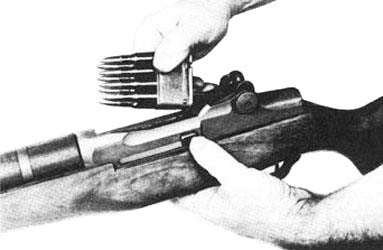
U.S. Army. Via Wikimedia
Commons
Either kind of magazine had to be reloaded with fresh rounds once it was emptied. In some cases the ammunition was supplied in a clip that was inserted as a unit into the magazine (an en bloc clip), and which could be removed when empty and replaced with a fresh clip. This largely eliminated the need for a removable magazine.
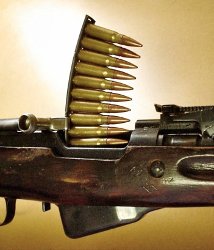
Other magazines, particularly on older weapons, could be
loaded with individual bullets, or they could be loaded from a
charger (also known as a stripper clip.) The charger was placed on
the top of the magazine and the rounds in the clip were pressed
down with a thumb to "strip" them into the magazine. The empty
charger was then usually discarded.
Revolvers were handguns that used a revolving cylinder to hold ammunition. They were reloaded by either breaking open the action or by swinging the cylinder to one side.
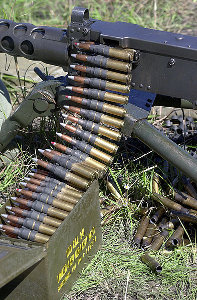
Ammunition for light machine guns was usually stored in
a large magazine or fed from a hopper. Medium and heavy machine
guns capable of very high volumes of fire used belted ammunition,
in which hundreds of rounds were clipped into a long belt. Belted
ammunition could be further subdivided into disintegrating and
non-disintegrating belted ammunition. Older machine guns used
non-disintegrating belts, in which rounds were inserted into
individual pockets or clips in a continuous cloth or metal belt.
Each round was extracted in turn from its pocket by the machine
gun, leaving an empty belt that could be reloaded by hand.
Disintegrating belts consisted of rounds connected to each other
by metal links, and as each round was extracted from its links,
the links fell apart and were ejected from the machine gun.
Disintegrating belts were widely used for aircraft machine guns,
where the trouble of dealing with empty belts was not worth the
ease and economy of reloading the belt. In land or sea warfare,
the links could be gathered up and reused, though it required
special tools to reassemble links and fresh rounds into a new
belt.
A few machine guns used strip ammunition, which functioned like short, rigid ammunition belts. In practice, strip ammunition combined the worst features of belted and magazine ammunition.
Actions. Bolt-action
weapons
were
loaded manually. The soldier worked a handle on the bolt that
pulled the bolt back from the chamber and extracted any spent
round, then pushed the bolt forward, inserting a fresh round into
the chamber and cocking the firing pin. This had to be done after
each round was fired. By contrast, automatic weapons used some of
the energy of a fired round to automatically load and fire the
next round. The mechanism for tapping this energy (the action)
operated in one of three ways.
Recoil actions took advantage of the recoil of the entire bolt and barrel assembly to work the loader. This was a simple and robust approach, but because the heavy barrel recoiled at relatively low velocity, pure recoil actions were not capable of a high rate of fire. Recoil actions were further subdivided into into short recoil and long recoil actions. In long recoil actions, the barrel and bolt recoiled together, then the bolt was unlocked and a recoil spring forced the barrel back forward while extracting the spent round. After the barrel had moved forward, the bolt was released and also moved forward, chambering a new round and locking back onto the barrel. In short recoil actions, the barrel and bolt recoiled together for only a short distance before the bolt was unlocked and the barrel was brought to a halt. The bolt continued back to eject the spend round, then a recoil spring pushed the bolt forward, chambering the next round and locking the bolt back onto the barrel. The bolt and barrel then moved forward the remaining short distance into firing position. Recoil actions could also be subdivided into open bolt or closed bolt actions. In closed bolt actions, the firing cycle began with the round already fully chambered and ready to fire. In open bolt actions, the firing cycle began with the bolt fully recoiled. When the trigger was pulled, the bolt was released to move forward, load the first round, and fire it. Open bolt actions were mechanically simpler and had less tendency to overheat than closed bolt actions, since the chamber was open to the air between bursts, but the open bolt imposed a noticeable delay between pulling the trigger and firing the first round and had a greater tendency to be inaccurate with the first few rounds.
 |

|

|

|

|
Blowback actions relied on the recoil of the bolt alone.
The faster motion of the relatively light bolt improved the rate
of fire, but the bolt could not be locked to the rear of the
barrel at the moment of firing, because this would neutralize the
recoil. The resulting loose seal meant that blowback actions were
unsafe to use with high chamber pressures. Simple blowback actions
relied on the inertia of a relatively heavy bolt, which took
enough time to recoil that the bullet was already out of the
barrel and the chamber pressure reduced to safe levels before the
chamber was opened. Advanced primer ignition (API) blowback
actions were open bolt actions that fired the round while the bolt
was still moving forward into the chamber. Thus the recoil had to
overcome not only the inertia of the bolt, but also its forward
momentum, which permitted the use of a lighter bolt and more
powerful ammunition. This also improved the rate of fire and
reduced the recoil felt by the operator. However, API blowback
actions had to be finely tuned to a specific cartridge.
Gas actions tapped some of the gas out of the barrel to
push on a piston that worked the loader. This mechanism was
complicated, but allowed a high rate of accurate fire.
There were many variations on the three basic actions,
and some weapons, such as the German
MG42, used a combination of recoil and gas mechanisms (boosted
recoil) to achieve a very high rate of fire.
Whichever action was used, an automatic weapon kept
firing as long as the trigger was kept pulled and there was
ammunition remaining. However, rapid fire generated a great deal
of heat while expending large amounts of ammunition, so automatic
weapons were usually fired in short bursts to saturate a small
target area. They were also equipped with a cooling system to
dissipate heat more rapidly. Air-cooled weapons had cooling fins
or jackets that increased the area in contact with the air.
Liquid-cooled systems circulated water or some other coolant from
a reservoir to a jacket around the barrel. The best liquid-cooled
systems could keep the barrel cool indefinitely, so that the
weapon could fire almost nonstop for hours. Air-cooled systems
were not as efficient, and the weapon had to cease firing at
intervals to allow the cooling system to catch up with the heat
generated.
Semiautomatic weapons resembled automatic weapons in that part of the energy of a fired round was used to automatically load the next round. However, this round was not automatically fired. A separate pull on the trigger was required to fire each round, as with a bolt-action weapon, but there was no need to work the bolt between shots. This simplified the firing cycle and meant that less training was required for a rifleman to achieve a high rate of aimed fire.
Other Components. The part of a weapon that
housed the working parts (typically the barrel breech, bolt,
magazine port, firing pin, and trigger mechanism) was known as the
receiver. This was the heart of the weapon and was often imprinted
with a unique serial number. (Such imprinting is required by law
in most 21st century nations.)
Rifles and submachine guns typically had a stock, which
was a wooden or metal frame structure to the rear of the receiver
that rested against the infantryman's shoulder when he fired the
weapon. This both steadied the weapon and allowed the shoulder to
absorb the recoil. The stock of a rifle was also sometimes spoken
of as the butt of the rifle.
Small arms had sights used to aim the weapon, typically
taking the form of either forward and rear sights that were lined
up with each other and the target or a small telescope equipped
with cross hairs. The latter was rarely used except on sniper rifles. Many small arms
had adjustments to their sights that not only allowed the sights
to be calibrated, but also allowed the sights to be adjusted for
the curved trajectory of a bullet fired at long range.
A variety of small arms were employed within the
infantry platoon.
Pistols were used by every army engaged in the Pacific War, typically as side arms for officers and NCOs and for crews of heavy weapons, tanks, and aircraft. They were short-range defensive weapons. Pistols typically fired a relatively heavy bullet at low muzzle velocity and with limited accuracy. All military pistols were either revolvers or semiautomatics with a magazine capacity of six to eight rounds.
Rifles were the traditional mainstay of the infantry squad. Most were capable of
accurate fire at ranges of hundreds of yards in the hands of a
trained marksman. Most armies began the war equipped with
bolt-action rifles, but gas-action semiautomatic rifles were
introduced by the United
States early in the Pacific War. A rifle magazine typically
held five to ten rounds.
Carbines were short, lightweight rifles introduced to
give more defensive firepower to heavy weapon crews. They were
also used by paratroopers,
for whom their lighter weight was important.
Antitank rifles were large-caliber, high-velocity rifles that fired a very heavy armor piercing round. They could not penetrate armor thicker than about 30mm (1.2 inches), but could be devastating against light tanks and armored cars. They were replaced with more effective shaped-charge weapons as the war progressed.
Machine guns were fully automatic weapons supplied with large quantities of ammunition. Most machine guns were crew-served weapons, meaning that more than one man was required to operate the machine gun at full firepower. Typically one man was the gunner, responsible for aiming and firing, and one or two other men were loaders, responsible for keeping the machine gun supplied with ammunition. Since machine guns were heavy, it was also useful to have more than one soldier to carry parts of the gun or its ammunition.
Machine guns were further categorized as light, medium,
or heavy machine guns. Heavy machine guns were distinguished by
their use of a heavy round, at least 0.50 caliber (12.7mm), but
the distinction between light and medium machine guns was often
made more on the basis of intended use than on any weapons
characteristics: Light machine guns were meant to be issued to
individual infantry squads, while medium machine guns were
controlled at the platoon level or above.
It became increasingly clear during the Second World War that machine guns were the main source of firepower for the line infantry. Allied operational researchers concluded that a machine gun had the firepower of nine riflemen. The Germans realized this well before hostilities commenced, and their riflemen were taught that keeping the squad machine gun firing was their primary task. The British were very slow to accept the diminished role of riflemen, while the United States tried to employ the Browning automatic rifle in the role of a squad light machine gun, with only limited success. The Japanese never really accepted firepower as the arbiter of combat success, but their formal platoon organization was based on the German model and they made particularly effective use of machine guns in defensive situations.
Another trend in small arms during the Second World War
was the increased use of submachine guns for close-quarter
fighting. A submachine gun is essentially a fully automatic pistol
with a large magazine, and most submachine guns used pistol
ammunition. All participants in the Pacific War were slow to adopt
them, with the exception of the U.S. Marines, who quickly
embraced the Thompson submachine gun. The British eventually made
extensive use of the Sten gun. The Japanese produced submachine
guns only in very limited quantities, which saw combat primarily
with their paratroops.
The Japanese deployed some fine small arms, but many others were clumsy and mediocre, and the Japanese did a poor job of standardizing on ammunition. This fragmented the already inadequate Japanese munitions industry.
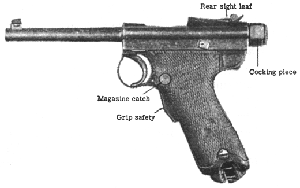
Nambu pistol
U.S. Army. Via ibiblio.org
Japanese pistols were uniformly poor, possibly because
of the strong tradition of the sword as an
officer's proper sidearm. The most common pistol was the Nambu, an
8mm semiautomatic which superficially resembled the German Luger,
but which was marred by a badly-placed safety and a magazine that
was much too difficult to remove when empty. The striker spring
was too light and quickly wore out, causing misfires, so the
standard holster came with a pocket for replacement springs. The
Nambu was expensive to build, so the Japanese began issuing the
Type 94, another 8mm semiautomatic, which had a very low muzzle
velocity, was prone to accidental firing, and was mechanically
very unreliable. It is widely regarded as the worst military
pistol ever issued, and one authority has stated that "the Type 94
is a pistol that should not be carried or fired; it is a
collector's piece only" (Bishop and Drury 1987).
Type 04 Nambu Pistol
|
Type 94 Pistol
|
|
Arisaka Type 38 rifle with
bayonet |
 Arisaka Type 99 rifle with bayonet U.S. Army. Via ibiblio.org |
The Japanese rifle was almost always the Arisaka, a bolt action rifle based loosely on the German Mauser that was little changed from the First World War. The original Type 38 fired a rather small 6.5mm round, which was upgraded to 7.7mm in the Type 99, based on combat experience in Manchuria. However, both rifles remained in service, complicating the supply situation. Most of the Type 99 went to Manchuria. The integral magazine could hold five rounds. Because of the limitations of Japanese metallurgy, the barrel could not take a very high chamber pressure, but the Japanese compensated by making the barrel unusually long. The rifle came with an enormous bayonet that looked almost comical when carried by the average Japanese infantryman, who was shorter than his Western counterpart. However, the Arisaka proved satisfactory for jungle fighting, where its weak report and lack of flash and smoke aided concealment. On the other hand, its bullet made a distinctive cracking sound that was easily distinguished from Allied rifles during firefights, and some Japanese veterans envied the higher effective rate of fire of Allied rifles.
Both the Type 38 and the Type 99 came in carbine
versions, and these were issued almost interchangeably with the
long rifles. The Type 97 sniper
rifle was essentially a Type 38 with a telescopic sight, a
modified bolt to clear the sight, and a wire monopod. There was
also a sniper version of the Type 99.
As the blockade on the Japanese home island tightened,
the quality of arms manufacture deteriorated markedly. The basic
Arisaka design was simplified as much as possible and inferior
materials and workmanship were evident in rifles produced after
1943. There was even some production of single-shot rifles using
8mm pistol ammunition and of black-powder rifles.
Arisaka Type 38 Rifle
|
Artisaka Type 99 Rifle
|
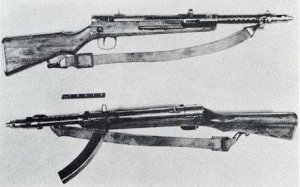
The Japanese produced a limited number of Type 100
submachine guns, mostly for paratroopers. This weapon came with a
bayonet and was rather rifle-like in appearance, suggesting that
the Japanese had the same confusion about the proper role of
submachine guns as was evident with other nations. It may also
have been largely symbolic in an army that retained an
anachronistic fondness for cold steel. The Type 100 used the
feeble 8mm pistol round and was mechanically unreliable, but the
barrel was chrome-plated, which gave it a long life and
considerable resistance to dirt. Few reached the front line,
except possibly in parachute units. The parachute version was
equipped with a folding stock and saw service in the attack on Palembang.
Type 100 Submachine Gun
|

Type 92 machine gun
U.S. Army. Via ibiblio.org
The Japanese were fond of machine guns and based most of
theirs on the French
Hotchkiss. The Type 92 medium machine gun, known to the Allies as
the "Woodpecker" because of its relatively slow rate of fire, was
nonetheless an effective support weapon and popular with the
troops. However, the extraction mechanism was violent enough that
an oil reservoir had to be added to oil the cartridges. This acted
as a powerful dirt magnet and made for very rapid chamber wear.
Other drawbacks of the Type 92 were its considerable weight (122
lbs or 55.5 kg) and its use of 7.7mm 30-round strip ammunition
instead of belts. The weight was overcome by providing sockets for
poles in the front two legs of the tripod mount and a pair of
handlebars for the back leg (visible in the photograph above),
which allowed three men to pick up and move the weapon without
disassembling it first. The weapon was air cooled via large
cooling fins on the barrel.
Type 92 Machine Gun
|
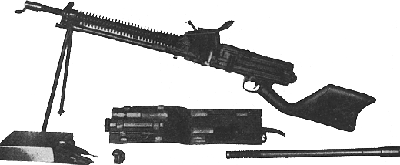 Type 11 machine gun U.S. Army. Via ibiblio.org |
Type 96 machine gun U.S. Army. Via ibiblio.org |
The Type 11 light machine gun was intended from the
start as a squad machine gun, and it was fed from 6.5mm rifle
clips fed into a hopper. However, the feed mechanism proved too
weak for regular rifle cartridges, so a special low-power round
had to be developed, eliminating the advantage of using rifle
clips and further complicating supply. Like the Type 92, the Type
11 used oiled cartridges that attracted grit and had large cooling
fins that made it an ugly, clumsy-looking weapon. The Type 11 was
replaced by the similar Type 96 beginning in 1922. The new design
still required low-power cartridges, and it eliminated the oil
reservoir in favor of oiling the cartridges when they were loaded
into the magazine. If anything, this was worse than the oil
reservoir. The Type 96 also had a small telescopic sight and,
incredibly for a machine gun, a bayonet socket.
Type 11 Light Machine Gun
|
Type 96 Light Machine Gun
|
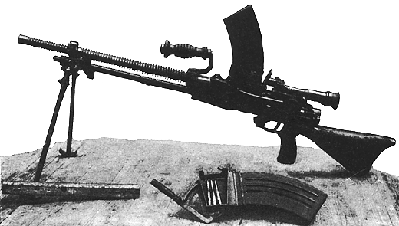
In the Type 99 the Japanese finally had a reliable and
effective machine gun. It used the newer 7.7mm rifle caliber and
did away with oiled cartridges. However, it required more
extensive machining and could not be produced as rapidly as the
situation demanded, and it did not reach the front lines until
1943.
Type 99 Light Machine Gun
|
In spite of their limitations, the Japanese made
excellent use of their light machine guns as squad weapons,
employing them well forward, in ambush,
and even as a sniper weapon.
Each infantry squad had a light machine gun, and each battalion had a machine gun company of two platoons with
four medium machine guns each.

U.S. Army. Via
Wikipedia
The Japanese Type 97 antitank rifle was a large, very heavy weapon that fired its 20mm rounds only in fully automatic mode. It could be manhandled to a new firing location, using a special carrying arrangement not unlike that of the Type 92 machine gun, though this took four men. The weapon was quite complicated, probably to reduce the violent recoil to a tolerable level. It was expensive to manufacture, and the authorized allotment was just two per battalion. There are indications that even this sparse allotment could not be met, though some were used (to little effect) at Okinawa and a few might have been used to shoot at armored landing craft in the islands of the Pacific.
Type 97 Antitank Rifle
|
The 13.2mm
Type 93 heavy machine gun saw limited use in land warfare.
British small arms, which were also used by Australians and New Zealanders, were
distinguished by extreme conservatism, which meant that most were
simple and reliable but otherwise undistinguished. With the
exception of the older revolvers still in service, all British
small arms used either the 9mm Parabellum or the 0.303 SAA rimmed
cartridge , which simplified production and logistics. The 0.303
was not ideal for machine guns but there were factories throughout
the Empire set up for its manufacture.
|
Enfield revolver Copyright © "Commander Zulu". Via Wikimedia Commons |
Browning semiautomatic pistol Copyright © Bob Adams. Via Wikimedia Commons |
The most common pistol was the Enfield revolver, which
fired a 0.38 round and required considerable training for
effective use. One flaw was that it required a very strong trigger
pull, which tended to spoil the aim. It was not popular. It was
supplemented by the much better American Smith and Wesson 0.38
revolver. An even better pistol was the Browning 9mm
semiautomatic, which had a large magazine (13 rounds) and was
immensely popular with the commando
and airborne units lucky
enough to receive it. The Browning was originally manufactured in
Belgium, but plans were brought to Britain in 1939 and production
began in Canada in 1943,
initially for the Chinese but
then for the British.
Enfield Revolver
|
Smith and Wesson 1917 Revolver
|
Browning Model 35 Hi-Power Pistol
|

Enfield rifle
Copyright © "Commander Zulu". Via Wikimedia Commons
Britain never put a semiautomatic rifle into service,
sticking with the Lee-Enfield bolt action rifle to the end of the
war. This was an excellent rifle, capable of very rapid and
accurate fire, but only if the soldier was exquisitely
well-trained in its use. The magazine held ten rounds and was
detachable, but was usually loaded from clipper strips while in
the field. The rifle used a 0.303 round that was unnecessarily
powerful and required very careful loading to avoid jams. In spite
of its drawbacks, the Enfield was beloved by the troops, and few
ever picked up a Garand in preference their Enfield.
Lee-Enfield Rifle Number 4
|
The Lee-Enfield had a relatively short barrel, which was
intended to allow it to bridge the gap between rifle and carbine.
However, the British later produced a true carbine version, the
Number 5 Mark I, for use in jungle
fighting. Though very light, it used the same 0.303 cartridge that
was already unnecessarily powerful for a long rifle, which gave it
a nasty recoil and poor accuracy. It was deeply unpopular and was
dropped from service after just a year and a half.
Lee-Enfield Rifle Number 5
|
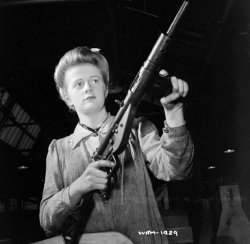
Library and Archives Canada. Via Wikimedia
Commons
Britain was slow to accept the submachine gun concept, considering this a "gangster weapon" unsuitable for the military. Military authorities clung to the view that infantry were to engage the enemy at 600 yards with aimed rifle fire, and turn to the bayonet at close range. Fraser (2007) captured the British infantryman's attitude:
I had grown to love my old snub-nosed Lee Enfield, and resented having to part with it, but it was usual for a section 2i/c [second in command] to carry a Thompson if one were available, so I accepted the thing and detested it. It was ugly, ungainly, I hadn't been trained in its use or taught to regard it as a wife, and it couldn't have come within ten feet of a falling plate at two hundred yards. Its whole purpose was automatic, and my view was that if single aimed shots had been good enough for the Duke of Wellington, they were good enough for me. For some reason I felt like a bully, just carrying it, and it rusted like an old bed-frame. I threw it in a Sittang creek, eventually, but in the meantime I had to go about like Lance-corporal Capone.
But somehow the British came up with the Sten gun,
arguably the most successful submachine gun of the war. It was
flimsy and prone to jamming, but it also was very easy to
manufacture, requiring only the simplest machine tools, and it was
easy to break down. Later versions were more robust and were used
in large numbers by the airborne forces. The gun was copied by partisan and resistance groups
in Europe and even by the Germans, who called theirs the MP3008.
It continued to be manufactured by irregular forces in the postwar
world.
Sten Mark II
|
|
Bren machine gun |
Vickers machine gun |
British machine guns were based on sensible and
effective designs. The Bren light machine gun, which was based on
the Czech Brno ZB26, was reliable, simple, and accurate and was
probably the best light machine gun of the war. Its only weakness
was a slight tendency to jam, due to the use of rimmed ammunition
requiring a curved magazine, but jams were quickly and easily
cleared. It was also an expensive gun to manufacture, and there
was little room for simplification other than discarding the
tripod mounting. It is still in use today. The Vickers-Berthier
light machine gun had a high rate of fire, as high as 1200 rpm in
the later versions, and was manufactured in Ishapore for use by the Indian Army. It closely resembled
the Bren and tended to be supplemented by it in the Indian Army as
the war progressed. The Vickers medium machine gun was a very old
design, based on the Maxim, that was viewed as all but infallible
by the British Army. It was water-cooled, which made it heavy and
clumsy, so that it required considerable manpower; but it could
fire for hours at targets up to 4000 yards away. During the Somme
offensive in the First World War, one Vickers fired an average of
10,000 rounds an hour for twelve hours without failure and while
remaining serviceable afterwards.
Bren Mark 2 Light Machine Gun
|
Vickes-Berthier Light Machine Gun
|
Vickers Medium Machine Gun
|
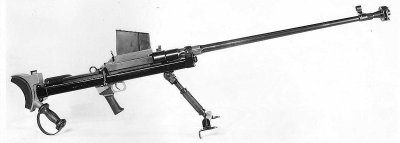
National Park Service. Via Wikimedia Commons
The Boys antitank rifle was manufactured in larger
numbers than any other antitank rifle in the world. It was adopted
in 1937, when its steel-cored 15mm bullet (fired at 3250 feet per
second or 1000 meters per second) could penetrate any tank in the
world, but like every other antitank rifle it quickly became
obsolete. Though equipped with a very thick rubber butt, it kicked
like a mule when fired. It was quite effective against Italian tanks in North Africa,
less so against the heavier German tanks. It was used to effect
against Japanese tanks in Malaya,
but by the time the British were engaging Japanese armor
formations again, it had been replaced with the PIAT shaped-charge
weapon.
Boys Mark 1 Antitank Rifle
|
American small arms were robust, reliable, based on
standardized ammunition types, and produced in huge numbers. All
American small arms except the 0.50 Browning heavy machine gun
used either the 0.45 (11mm) pistol round or the 0.30 (7.6mm) rifle
round, although a slightly less powerful version of the 0.30 was
used for the M1 carbine. The American Army emphasized firepower
and included a heavy weapons platoon in its company TO&E.
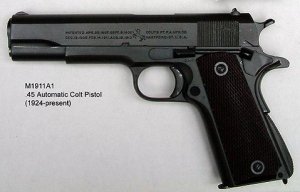
The Colt M1911A1 semiautomatic pistol was ubiquitous in
the American forces. This was an excellent design by American
inventor John Browning, whose large 0.45 round made it the most
powerful pistol used in the war. It was strong and safe, it was
remarkably accurate for a pistol, and it is still manufactured
today. It was probably the finest pistol produced during the war.
Its only drawback was that its round was arguably too powerful, requiring a
fair amount of practice to shoot the pistol accurately. There were
not enough to go around; the Navy was compelled to use the Smith
and Wesson revolver, which was not itself a bad weapon.
Colt M1911A1 Pistol
|
|
M1 Garand Rifle U.S. Army. Via Wikipedia |
|
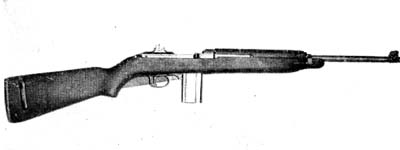 M1 Carbine U.S. Navy. Via ibiblio.org |
The United States was the first nation to arm its troops
with a semiautomatic rifle, the M1 Garand. This excellent weapon
had a distinctive double-barrel appearance due to the presence of
the gas recoil mechanism under the actual barrel. It was robust
and hard-hitting, and it had remarkably little tendency to kick up
when fired. It also used the same ammunition as the 1913
Springfield, of which vast quantities were left over from the
First World War. The magazine had the unique and somewhat peculiar
feature that it automatically ejected the clip when emptied,
leaving the action open for loading a fresh clip into the
magazine. Though this theoretically increased the maximum rate of
sustained fire, the distinctive sound made by the ejected clip
when landing on hard ground could be a tactical disadvantage, and
it was not possible to top off the clip without removing it from
the magazine first. The most important weakness of the Garand in
jungle fighting was that the gunpowder used in its cartridges
produced a bright flash and a large puff of smoke, spoiling
concealment.
A carbine version of the Garand, the M1 Carbine, was
also introduced. It was quite popular because of its light recoil
and pleasant handling. It used a short-stroke gas piston in place
of the long-stroke piston in the Garand rifle, so it lacked the
double-barreled appearance. The carbine fired a pistol cartridge
and so was somewhat lacking in accuracy and stopping power.
Experimental versions with a capability for full automatic fire
and a 30-round magazine never saw operational use, but it became
common practice to attach a canvas pouch to the stock with a
couple of extra magazines, in anticipation of rapid fire.
There were not enough Garands to go around at first, and
many of the early actions of the Pacific War were fought with the
1903 Springfield bolt action rifle. The Springfield was similar to
the Enfield but fired a slightly smaller 0.30 round and had an
integral magazine holding five rounds. Its bolt was also slightly
more difficult to work, giving it a slightly slower rate of fire.
One peculiarity was that it had a magazine cutoff so that it could
act as a single-loader rifle. This rifle continued to be
manufactured until 1944, though by then it was primarily used in
rear areas or by snipers. Like the British Enfield, it could be
very accurate in well-trained hands, and some Marines were reluctant to
exchange theirs for Garands.
Springfield M1903
|
M1 Garand Rifle
|
Carbine M1
|
A small number of Marine parachute units made use of the M1914
Johnson rifle, which was a recoil-driven semiautomatic rifle with
a 10-round magazine. However, the desire to standardize weaponry,
combined with the lesser degree of development of the weapon,
ensured that it never saw widespread use.
|
Thompson submachine gun |
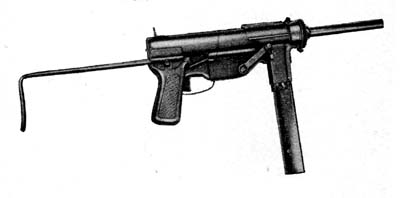 M3 submachine gun. U.S. Navy. Via ibiblio.org |
The most famous American submachine gun was the
Thompson. This controversial weapon fired 0.45 pistol rounds at
low muzzle velocity, giving it a very short range but great
stopping power. It was heavy and very expensive to manufacture,
required constant maintenance, and had a tendency to overheat.
When fired in combat, it sounded similar to the Japanese Type 92
machine gun, which meant that a soldier firing the Thompson might
draw fire from his own
side. Australian troops were fond of the Thompson, as were those
American troops who fought alongside the Australians in New Guinea, but the Thompson
was not popular with troops fighting in the Solomons.
The U.S. Army replaced the Thompson with the M3 "Grease Gun", a simple and easily manufactured weapon that deserved a better reputation than it got. The M3 had a slow enough rate of fire that it could easily be held on target and needed no single-shot arrangement. It cost about half of what a Thompson cost, and it was all but immune to dirt. It could also be rapidly converted to fire German 9mm ammunition. But it looked cheap and was not well liked.
The Marines experimented with the Reising, which became the principle individual small arm of 1 Marine Parachute Battalion during the Guadalcanal campaign. A closed bolt design, this submachine gun proved overly complicated and mechanically unreliable (the Marine paratroopers soon dubbed it the "Rusting Gun"), and the Americans ended up trying to dump most of the production run on their allies.
M1 Thompson Submachine Gun
|
M3A1 Submachine Gun
|
Shotguns, which fire a pattern of small pellets rather than a single large bullet, were banned by the Geneva Convention and were therefore not standard issue. However, some Americans regarded the Geneva shotgun ban as an outrageous anachronism in a day of high-velocity bullets and high explosives, and a few shotguns found their way to the front line. Shotguns were lethal at short range, but lost their punch so rapidly that they were excellent for avoiding friendly fire casualties in half-blind situations.
|
0.50 Browning machine gun |
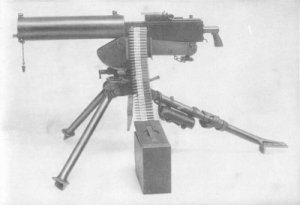 Browning 0.30 machine gun with water cooling U.S. Navy. Via ibiblio.org |
The American medium machine gun was the 0.30 Browning M1919, which came in both water-cooled and air-cooled versions. The water-cooled Browning, like the British Vickers, could fire indefinitely, but by the end of the war, almost all Brownings still in service were air-cooled. The heavy machine gun was the 0.50 Browning M2, which was thought to have enough armor-penetrating capability that the American Army never fielded an antitank rifle. The 0.50, which is still in use today, has superb ballistics but is very heavy and lacked the rate of fire required for the antiaircraft role. Both Brownings were considered resounding successes in land combat.
Browning 0.30 M1919A4 Machine Gun
|
Browning 0.50 M2 Machine Gun
|

Army
Heritage Museum. Via Wikipedia
The great weakness in American small arms was the lack of a decent light machine gun. The U.S. Army chose instead to equip its squads with the Browning M1918A2 automatic rifle, which proved too light to be a good light machine gun and too heavy to be a good automatic rifle. Though designed to be fired from the hip, its recoil was violent enough that it was almost impossible to keep this weapon on target, and later versions came with a bipod for firing from the prone position. Its small magazine (20 rounds) was inadequate for the role this weapon was asked to fill. The action was too light, making the weapon subject to rapid wear. Nevertheless, the BAR was popular with the troops, perhaps out of national chauvinism or because they didn't know better.
Browning Automatic Rifle
|
It need not have been so. The Johnson light machine gun,
developed in the mid-1930s from the M1914 Johnson rifle, was a
serviceable weapon with potential for further refinement, but only
a small number were produced for the Marines and Rangers after an order for
the Netherlands
East Indies was canceled when that area was overrun by the
Japanese. This weapon was so arranged that air could flow through
the barrel to cool it after every burst. Some sources claim it was
easily topped off with Springfield rifle clips, but this is
dubious given the horizontal placement of the magazine. Its rate
of fire was highly adjustable. It was not mechanically robust, and
it is not clear if the weapon could be belt-fed, but these
problems might have been solved with further development if the
Army had not been so committed to the BAR.
An attempt later in the war to produce a light machine
gun from the medium 0.30 Browning failed to catch on, so the
Americans fought the entire war without an adequate squad light
machine gun. However, Marine corporal Tony Stein carried a light
machine gun on Iwo Jima
which had been improvised from a 0.30 Browning salvaged from a
wrecked Navy aircraft. He used the weapon to effect during the
battle, winning a posthumous Medal of Honor. Accounts differ on
whether this weapon, known as the "Stinger", was Stein's invention
(Leckie 1962) or was improvised by Sergeant Mel Grevich, who had
time and resources to provide just six "Stingers" to his battalion, which included
Stein (Morgan 2006.) Since it was improvised from an aircraft
machine gun meant to be cooled by the slip stream, it would almost
certainly have had serious problems with overheating in land
combat, and accounts agree that it was voracious in its appetite
for ammunition. The improvisation was never officially adopted nor
are there any indications it saw service outside of 5
Marine Division.
For the most part, the Australians used the same weapons
as the British, but there were two interesting exceptions. The
Australians built their own version of the Sten, known as the
Austen (from "Australian Sten"). This was more reliable than the
original Sten, but its buttstock was built too long for comfort
for most soldiers.
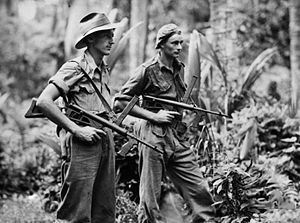
The Australians had meanwhile come up with their own submachine gun, the Owen, which was much more popular. The Owen was a very odd weapon, with its 33-round magazine sticking straight up above the action. As a result, the sights had to be offset to the right. However, the magazine was quite reliable, in part because gravity worked with rather than against the feed, and the action itself was carefully sealed against dirt. The weapon was difficult to manufacture and rather heavy, but was robust and well liked by the troops. It remained in service until 1962.
Owen Machine Carbine
|
There were manufacturing facilities in Australia for an
earlier version of the Lee-Enfield rifle, the Number 1 Rifle,
which thus saw some use by Australians in the Southwest Pacific.
It was slightly lighter and had a slightly lower muzzle velocity,
was significantly more difficult to manufacture, but was otherwise
identical to the Lee-Enfield Number 4 Rifle.
China was almost competely
dependent on imported small arms for its army. Domestic arms
production was limited to a small number of weapons of older
German design produced under license, such as Mauser rifles and
Maxim machine guns. These also were the chief weapons found in
front line units in the early part of the war. American weapons
began to appear as the war progressed, though these were usually
whatever could be spared rather than the latest models. There were
never enough weapons to go around, and one estimate is that up to
a third of the men in most Chinese divisions carried no firearms
at all. These men were employed as human pack animals, since there
were not enough horses, let alone motor
vehicles, to meet transportation needs. Based on
contemporary photographs, many Chinese troops carried dadao swords for close
combat.
The Chinese did receive the first Canadian production run of the Browning 9mm automatic pistol, and were particularly fond of the rather bizarre wooden holster stock optimistically developed for the weapon. This converted the pistol into a kind of ersatz carbine.
Another weapon foisted on the Chinese was the Mauser Model 1932 machine pistol. This weapon was much too light for any but the first round of a burst to come near the target, and it was so poorly cooled that it was dangerously prone to "cooking off": After a few bursts, the weapon spontaneously fired itself from residual heat in the chamber.
Curiously, the Chinese manufactured a number of copycat Thompson submachine guns, in spite of their complexity. If typical Chinese Nationalist Army practice was followed, these would have been issued only to trusted troops far behind the front line, where the weapons were less likely to be lost in battle.
Some 576 British Boys antitank rifles were supplied to the
Chinese in early 1943 for use in Burma.
References
"Handbook
on Japanese Military Forces" (1944-9; accessed 2012-3-13)
Morgan (2006; accessed 2011-5-30)
OPNAVE 33-40 (1944; accessed 2012-11-28)
The Pacific War Online Encyclopedia © 2007-2009, 2011-2013, 2016 by Kent G. Budge. Index